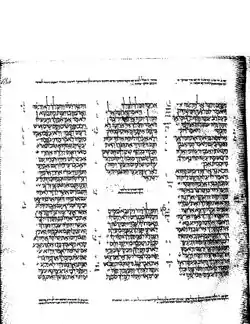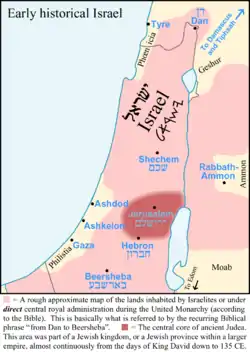| 1 Kings 4 | |
|---|---|
 The pages containing the Books of Kings (1 & 2 Kings) Leningrad Codex (1008 CE). | |
| Book | First book of Kings |
| Hebrew Bible part | Nevi'im |
| Order in the Hebrew part | 4 |
| Category | Former Prophets |
| Christian Bible part | Old Testament |
| Order in the Christian part | 11 |
1 Kings 4 is the fourth chapter of the Books of Kings in the Hebrew Bible or the First Book of Kings in the Old Testament of the Christian Bible.[1][2] The book is a compilation of various annals recording the acts of the kings of Israel and Judah by a Deuteronomic compiler in the seventh century BCE, with a supplement added in the sixth century BCE.[3] This chapter belongs to the section focusing on the reign of Solomon over the unified kingdom of Judah and Israel (1 Kings 1 to 11).[4] The focus of this chapter is the reign of Solomon, the king of Israel.[5]
Text
This chapter was originally written in the Hebrew language and since the 16th century is divided into 34 verses.
Textual witnesses
Some early manuscripts containing the text of this chapter in Hebrew are of the Masoretic Text tradition, which includes the Codex Cairensis (895), Aleppo Codex (10th century), and Codex Leningradensis (1008).[6]
There is also a translation into Koine Greek known as the Septuagint, made in the last few centuries BCE. Extant ancient manuscripts of the Septuagint version include Codex Vaticanus (B; B; 4th century) and Codex Alexandrinus (A; A; 5th century).[7][lower-alpha 1]
Analysis
The structure of the first 28 verses of this chapter centers on the abundant provision of Solomon's table:[9]
- A Solomon's royal officials and officers (4:1–19)
- B Judah and Israel eat, drink and rejoice (4:20)
- C Solomon rules over kingdoms between the Euphrates and Egypt (4:21)
- D Provisions of Solomon's table (4:22–23)
- C' Solomon rules over kingdoms between the Euphrates and Egypt (4:24)
- C Solomon rules over kingdoms between the Euphrates and Egypt (4:21)
- B' Judah and Israel are living in safety (4:25)
- B Judah and Israel eat, drink and rejoice (4:20)
- A' Officers provide for Solomon's household (4:26–28)
The section starting from 1 Kings 4:29 to 1 Kings 5:12 is organized as a chiasm:[10]
- A Solomon's wisdom (4:29–34)
- B Hiram sends servants to Solomon (5:1)
- C Solomon's message to Hiram (5:2–6)
- B' Hiram's response to Solomon (5:7–11)
- B Hiram sends servants to Solomon (5:1)
- A' Solomon's wisdom (5:12)
Solomon's royal officials and officers (4:1–19)
The orderly structure of the kingdom shows the quality of Solomon's wisdom, resulting in happy and prosperous citizens, fulfilling not only the Abrahamic promise (Genesis 22:17), but also the fruit of Joshua's conquest (Joshua 11:23).[11][12] A comparison with David's list of officers (2 Samuel 8:16–18; 20:23–26) demonstrate the continuity and development of the court, with the increase of the number of ministers: some remained (Ado[ni]ram] and Jehoshaphat), some removed (Joab and Abiathar), one promoted (Benaiah), and some as rewards to his party followers (Zadok's son, Azariah, and Nathan's sons in verse 5).[5] Provincial governors were assigned in the twelve provinces of Israel, mainly of northern Israel, not including Jerusalem and the land of Judah, nor the 'foreign possessions' (verses 7–19).[5] The geographical organization of the list is interesting: beginning with the central mountains of Ephraim, moving north (Naphtali, Asher, and Issachar) and concluding with the south and south-east (Benjamin and Gad).[13]
Verse 6
- 'And Ahishar was over the household: and Adoniram the son of Abda was over the tribute.[14]
- "Over the household": from Hebrew: על־הבית, ‘al-ha-bā-yiṯ; a position first mentioned here, indicating the growing size of royal court; later in Ahab's and Hezekiah's court (cf. 1 Kings 18:3; 2 Kings 18:18; Isaiah 22:15).[15]
- "Adoniram": also mentioned in 1 Kings 5:14 and 12:18 where the name is spelled "Adoram" (cf. 2 Samuel 20:24);[11] also spelled as "Hadoram" (2 Chronicles 10:18).[16] He was stoned to death by the Israelites to whom Rehoboam sent him, as a collector of tribute, after the revolt of the ten tribes to Jeroboam.[17]
- "The tribute": or "forced labor" (NKJV), not the same as the Israelite labor force in 1 Kings 5:13 (cf. 1 Kings 11:28; 12:3–4).[11]
Solomon's prosperity and wisdom (4:20–34)

Under Solomon, the kingdom prospered and had a security from the neighboring states from the Euphrates to Egypt, while the state administration had become larger and more centralized since the time of Saul.[13] Verses 29–34 focus on Solomon's wisdom, a full circle of Solomon's history since 1 Kings 3:1–15, more on the academic aspect, instead of as a king or a judge.[13] In Solomon's time, science was already international, with the texts of wisdom from the whole of the ancient Near East (as found in archaeology) containing accumulated general knowledge. Solomon is named as the author of the many proverbs (verse 32; Proverbs 10:1; 25:1; hence also 1:1) and songs (Psalm 72, Psalm 127; Song 1:1).[13][18] He also has ability to enumerate creation in natural order (verse 33; cf. Job 38–39, Psalm 104, and Genesis 1).[13][18]
See also
Notes
- ↑ The whole book of 1 Kings is missing from the extant Codex Sinaiticus.[8]
References
- ↑ Halley 1965, p. 191.
- ↑ Collins 2014, p. 288.
- ↑ McKane 1993, p. 324.
- ↑ Dietrich 2007, p. 234.
- 1 2 3 Dietrich 2007, p. 236.
- ↑ Würthwein 1995, pp. 35–37.
- ↑ Würthwein 1995, pp. 73–74.
- ↑
 This article incorporates text from a publication now in the public domain: Herbermann, Charles, ed. (1913). "Codex Sinaiticus". Catholic Encyclopedia. New York: Robert Appleton Company.
This article incorporates text from a publication now in the public domain: Herbermann, Charles, ed. (1913). "Codex Sinaiticus". Catholic Encyclopedia. New York: Robert Appleton Company. - ↑ Leithart 2006, p. 48.
- ↑ Leithart 2006, p. 52.
- 1 2 3 Coogan 2007, p. 495 Hebrew Bible.
- ↑ Leithart 2006, pp. 48–49.
- 1 2 3 4 5 Dietrich 2007, p. 237.
- ↑ 1 Kings 4:6 KJV
- ↑ Exell, Joseph S.; Spence-Jones, Henry Donald Maurice (Editors). On "1 Kings 4". In: The Pulpit Commentary. 23 volumes. First publication: 1890. Accessed 24 April 2019.
- ↑ Note on 1 Kings 4:6 in Berean Study Bible
- ↑ Cambridge Bible for Schools and Colleges. 1 Kings 4. Accessed 28 April 2019.
- 1 2 Coogan 2007, p. 497 Hebrew Bible.
Sources
- Collins, John J. (2014). "Chapter 14: 1 Kings 12 – 2 Kings 25". Introduction to the Hebrew Scriptures. Fortress Press. pp. 277–296. ISBN 978-1451469233.
- Coogan, Michael David (2007). Coogan, Michael David; Brettler, Marc Zvi; Newsom, Carol Ann; Perkins, Pheme (eds.). The New Oxford Annotated Bible with the Apocryphal/Deuterocanonical Books: New Revised Standard Version, Issue 48 (Augmented 3rd ed.). Oxford University Press. ISBN 978-0195288810.
- Dietrich, Walter (2007). "13. 1 and 2 Kings". In Barton, John; Muddiman, John (eds.). The Oxford Bible Commentary (first (paperback) ed.). Oxford University Press. pp. 232–266. ISBN 978-0199277186. Retrieved February 6, 2019.
- Halley, Henry H. (1965). Halley's Bible Handbook: an abbreviated Bible commentary (24th (revised) ed.). Zondervan Publishing House. ISBN 0-310-25720-4.
- Hayes, Christine (2015). Introduction to the Bible. Yale University Press. ISBN 978-0300188271.
- Leithart, Peter J. (2006). 1 & 2 Kings. Brazos Theological Commentary on the Bible. Brazos Press. ISBN 978-1587431258.
- McKane, William (1993). "Kings, Book of". In Metzger, Bruce M; Coogan, Michael D (eds.). The Oxford Companion to the Bible. Oxford University Press. pp. 409–413. ISBN 978-0195046458.
- Metzger, Bruce M; Coogan, Michael D, eds. (1993). The Oxford Companion to the Bible. Oxford University Press. ISBN 978-0195046458.
- Würthwein, Ernst (1995). The Text of the Old Testament. Translated by Rhodes, Erroll F. Grand Rapids, MI: Wm. B. Eerdmans. ISBN 0-8028-0788-7. Retrieved January 26, 2019.
External links
- Jewish translations:
- Melachim I - I Kings - Chapter 4 (Judaica Press). Hebrew text and English translation [with Rashi's commentary] at Chabad.org
- Christian translations:
- Online Bible at GospelHall.org (ESV, KJV, Darby, American Standard Version, Bible in Basic English)
- 1 Kings chapter 4. Bible Gateway